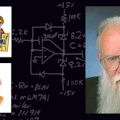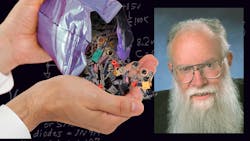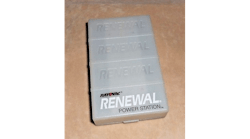This article is part of Bob Pease's Floobydust series found in the Electronic History section of our Series Library.
As we mentioned in this column a year ago, "floobydust" is a recently-coined term for "miscellaneous" or "potpourri," a regular jumble of ideas. Am I wrong??
Continuing on the subject of Fuzzy Logic, I must recommend a newsletter10 from one of the few promoters of F.L. who is a real engineer, not just an ivory-tower theoretician. The guy, Dave Brubaker, is thoughtful about solving real problems with F.L. I have learned more positive, useful information about F.L. from Dave's newsletter than from everybody else put together. NOT just platitudes. Ask him for a couple samples of his newsletter, and information on how to order it for $24 per year.
Read What's All This Floobydust Stuff, Anyhow? (Part 3)
All for now./Comments invited! RAP/Robert A. Pease/Engineer
Address: Mail Stop D2597A, National Semiconductor, P.O. Box 58090, Santa Clara,
CA 95052-8090
References:
- Fry's Electronics, 1177 Kern Ave., just off Lawrence Expressway, about 1/3 mile south of U.S. 101, Sunnyvale, Calif. Great assortment of electronic merchandise, from fuses and resistors and ICs up to fancy TV and electronic systems. Also stores in Palo Alto and Fremont. Inquire at 408-733-1770, 415-496-6000, or 510-770-3797.
- Ambico Inc., 50 Maple St., Norwood, N.J. 07648; phone: 1-800-621-1106.
- "Better use of dry batteries," Rod Cooper, Practical Electronics, July 1986.
- Ray-O-Vac "Renewal" rechargeable alkaline battery system. Charger costs only $30, nicely built, a real bargain. Special "Renewal" alkaline cells cost 2X more than ordinary alkaline cells; only the Renewal cells can be recharged in the recharger. Available in good department stores or electronics stores. I bought mine in Target.
- Eveready DA412P zinc-air battery can put out 4.8 V × 6.5 A-hr. That's about as much energy as 4 alkaline C-cells or 2 D-cells, but it weighs only 3.7 ounces, or a factor of 2.7 less. It costs $12 or a factor of 4.5 more than the alkaline cells. You can get this energy only if you draw less than 40 mA for longer than 160 hours. Minimum order is 75 pieces. Zinc-air is great for hearing aids—and for astronauts.
- The Audio Critic magazine: published quarterly, $24 per year, by: Critic Publications Inc., 1380 Masi Rd., Quakertown, PA 18951.
- Fluke Corp. Model 97, handheld meter and 50-MHz oscilloscope, 4 lb., $1950. Phone: 1-800-44-FLUKE.
- Dr. Science's Book of Shocking Domestic Revelations, ISBN 0-688-11444-X. $17.50 includes shipping. To order, call 1-800-989-DUCK.
- Home Power, published bi-monthly for $15 per year, by Home Power, P.O. Box 520, Ashland, OR 97520.
- David Brubaker, The Huntington Group, 883 Santa Cruz Ave., Suite 27, Menlo Park, CA 94025-4669.
About the Author

Bob Pease
Bob obtained a BSEE from MIT in 1961 and was a staff scientist at National Semiconductor Corp., Santa Clara, CA, for many years. He was a well known and long time contributing editor to Electronic Design.
We also have a number of PDF eBooks by Bob that members can download from the Electronic Design Members Library.

